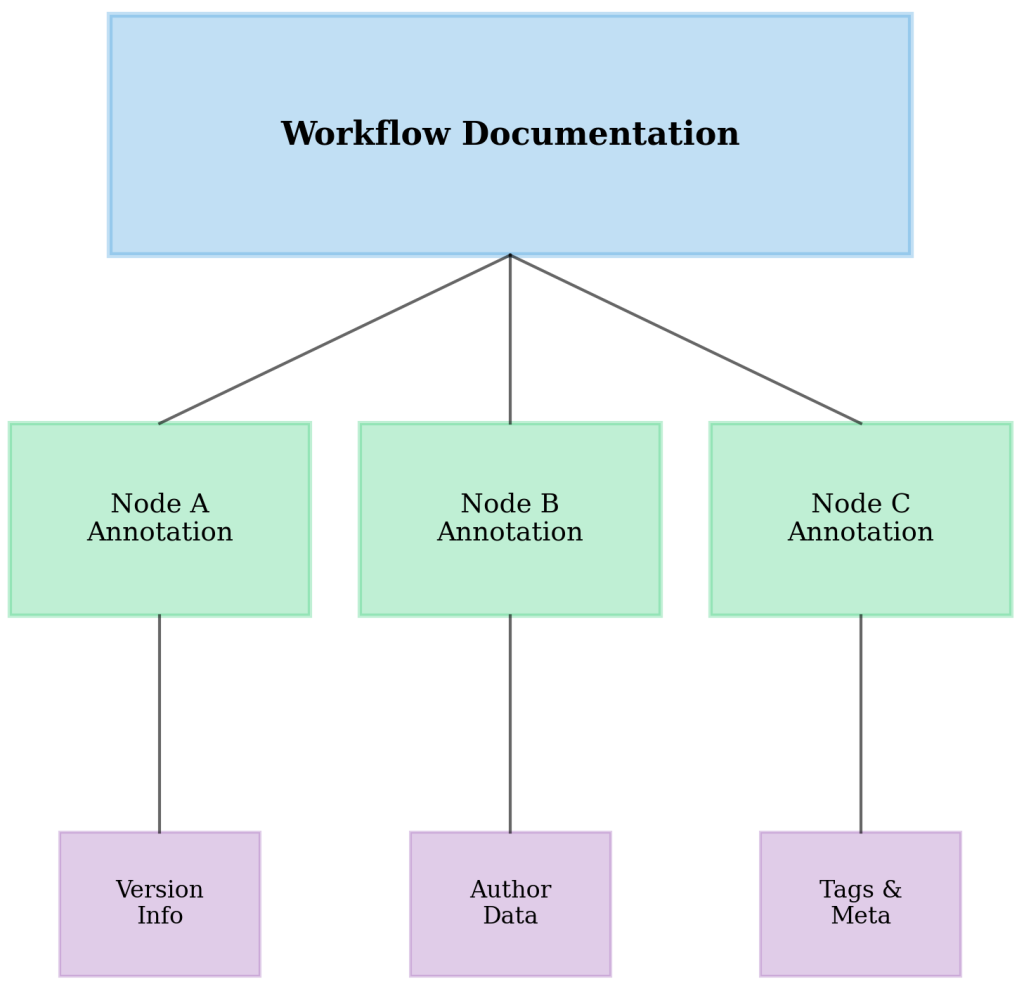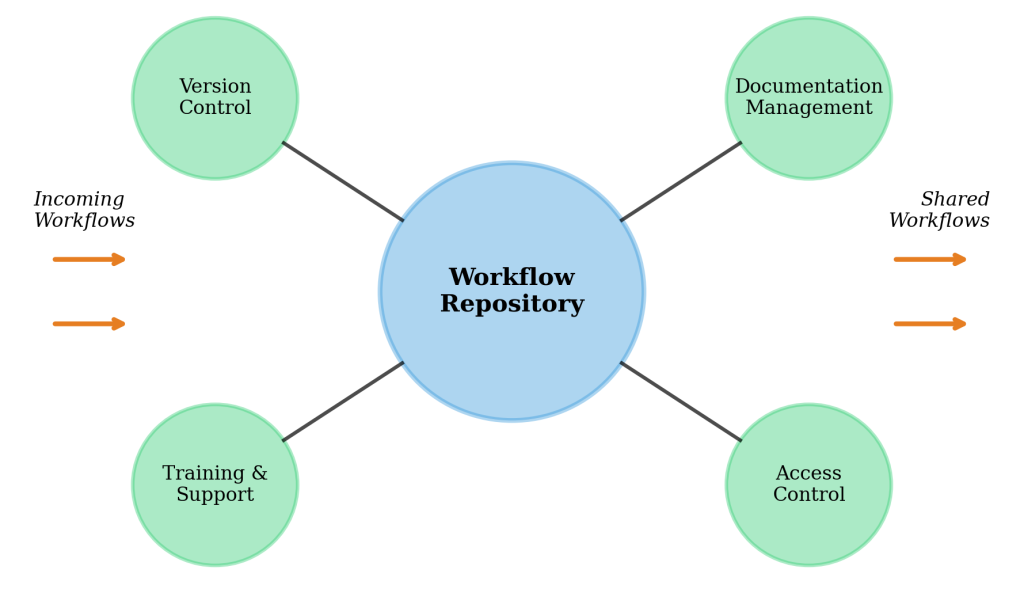Chapter 7.6: Workflow Documentation and Sharing Practices
This chapter examines the systematic documentation and sharing practices essential for professional workflow development and organizational collaboration. Key concepts include annotation strategies, version control methodologies, knowledge transfer protocols, and regulatory compliance frameworks that transform individual analytical processes into scalable organizational capabilities.
Professional Documentation Frameworks in Analytical Environments
Professional analytical environments require systematic documentation approaches that transform complex computational processes into comprehensible, maintainable systems. Workflow documentation encompasses multiple levels of information capture, from individual component explanations to comprehensive process overviews that enable knowledge transfer and regulatory compliance. These documentation frameworks serve as the foundation for organizational knowledge management, audit compliance, and collaborative development in data-driven enterprises.
GDPR Compliance Through Systematic Workflow Documentation
The implementation of General Data Protection Regulation (GDPR) in May 2018 created unprecedented documentation requirements for European financial institutions processing customer data. Phil Winters, internationally recognized as “The Father of Customer Intelligence,” documented how organizations used systematic workflow annotation to address regulatory transparency requirements while maintaining operational efficiency.
Financial institutions managing millions of customer records through credit scoring algorithms, fraud detection systems, and marketing analytics discovered that traditional undocumented analytical processes became compliance liabilities under GDPR’s requirement for complete data processing transparency. Institutions faced potential fines up to 4% of global annual revenue for inadequate documentation of data collection, processing, anonymization, and storage procedures.
KNIME Analytics Platform’s self-documenting workflow capabilities provided a systematic solution that enabled institutions to create reusable, annotated workflow templates with complete audit trails. These frameworks automatically documented each step of data processing, including detailed explanations of data sources, transformation logic, retention policies, and legal basis for processing, creating the transparency essential for regulatory compliance.
Annotation Strategies and Metadata Management
Comprehensive workflow documentation operates through hierarchical annotation systems that capture information at multiple levels of analytical complexity. Node-level annotations document individual component purposes, business logic, and data quality assumptions, providing detailed explanations of transformation procedures, validation criteria, and error handling approaches that enable team members to understand analytical choices without consulting original developers.
KNIME Annotation Implementation
The KNIME Analytics Platform provides comprehensive annotation capabilities through node-specific documentation that explains individual component purposes and business logic. Node Annotations enable detailed documentation of business rules, data validation criteria, and decision rationale by accessing the annotation feature through right-click context menus. These annotations include specific information about expected input formats, transformation logic, error handling procedures, and output specifications that support both collaborative development and regulatory compliance requirements.
Workflow Annotations provide overarching documentation that contextualizes entire analytical processes within business objectives and regulatory frameworks. The Workflow Annotation feature enables comprehensive descriptions that include project background, data source specifications, analytical methodology explanations, and business impact statements that facilitate stakeholder understanding and audit compliance.

Figure 7.6.1: Hierarchical documentation structure in KNIME Analytics Platform showing node-level annotations, workflow descriptions, and metadata organization. This visualization demonstrates how systematic annotation practices create comprehensive documentation that supports both collaborative development and regulatory compliance requirements.
Workflow-level documentation contextualizes entire analytical processes within broader business objectives and regulatory frameworks. This documentation includes project background, data source specifications, analytical methodology explanations, and business impact statements that enable stakeholders to understand how individual components contribute to organizational goals while satisfying audit and compliance requirements.
Metadata management systems facilitate systematic organization and retrieval of analytical assets across large organizations through structured information capture. Professional metadata includes author information, creation dates, modification history, business unit ownership, and regulatory classification that supports knowledge management and compliance tracking through searchable, categorized repositories.
Data Lineage Documentation
Data lineage documentation traces information flow from original sources through final deliverables, providing transparency essential for regulatory compliance and quality assurance. Professional data lineage includes identification of all source systems, transformation procedures, quality assurance checks, and output destinations that enable auditors and team members to understand complete data processing chains while maintaining analytical transparency.
Version Control and Collaborative Development
Professional workflow management requires systematic version control that maintains analytical integrity while supporting team-based development. Version control systems track modifications, manage branching and merging procedures, and maintain complete change histories that enable rollback capabilities and audit compliance in enterprise analytical environments.
Professional Naming Conventions
Systematic naming conventions provide critical infrastructure for version management through standardized formats that include version numbers, modification dates, author identifiers, and change descriptions. Professional conventions follow patterns such as “Customer_Scoring_v2.3_2024-08-15_SKumar_Updated_Risk_Thresholds” that enable teams to identify current versions and understand modification history without accessing detailed change logs.
KNIME Server integration provides enterprise-grade collaboration features including centralized workflow storage, access control management, and automated backup procedures that support team-based development. User permissions configuration restricts modification access to authorized analysts while enabling broader viewing permissions for stakeholders and auditors, ensuring governance compliance while maintaining analytical accessibility.
Collaborative development protocols balance analytical agility with governance requirements through access control management, approval workflows, and change management procedures. These systems implement approval workflows for critical analytical processes that require senior analyst review before deployment to production environments, ensuring quality control and regulatory compliance while supporting rapid analytical iteration.
Change Management and Governance
Change management procedures ensure analytical integrity through documentation standards that capture modification rationale, testing procedures, and stakeholder approval. Standardized change logs include business justification, technical impact analysis, testing results, and approval signatures that satisfy regulatory requirements while supporting agile analytical development. Rollback procedures enable quick restoration of previous workflow versions when modifications introduce errors or fail validation testing.
Knowledge Transfer and Organizational Scaling
Effective workflow sharing extends beyond technical file transfer to encompass comprehensive knowledge transfer that ensures successful adoption and maintenance by receiving teams. Professional sharing packages include workflow files, comprehensive documentation, sample data sets, validation procedures, and troubleshooting guides that enable independent operation without ongoing support from original developers.

Figure 7.6.2: Workflow sharing and collaboration ecosystem demonstrating the central repository concept with surrounding collaborative components including version control, documentation management, training resources, and access control. This framework illustrates how systematic sharing practices enable organizational scaling through reusable analytical assets and distributed collaboration.
KNIME Hub Integration and Organizational Repositories
KNIME Hub integration facilitates organizational knowledge sharing through internal workflow repositories that maintain access controls while enabling discovery and reuse of analytical assets. Organizational spaces categorize workflows by department, project type, or analytical methodology while implementing search capabilities that help analysts discover relevant existing workflows before developing new solutions.
Contribution guidelines specify documentation requirements, quality standards, and review procedures for shared workflows, ensuring consistent quality and usability across organizational analytical assets. These guidelines establish minimum documentation standards, testing requirements, and approval processes that maintain repository quality while encouraging knowledge sharing and collaboration.
Training and support procedures ensure sustainable knowledge transfer through documentation that enables self-service learning and reduces dependency on original developers. Professional support systems include video tutorials that demonstrate workflow execution and parameter modification, troubleshooting guides that address common issues, and help desk procedures that track questions and solutions to inform continuous documentation improvement.
Regulatory Compliance Through Documentation
Healthcare analytics environments implement workflow documentation to ensure HIPAA compliance, enable peer review processes, and support reproducible clinical research across multiple institutions. Financial services organizations document risk assessment workflows to satisfy regulatory requirements including Basel III, Dodd-Frank, and MiFID II compliance frameworks. Manufacturing environments utilize workflow documentation to maintain ISO certification and ensure consistent quality standards across facilities.
Industry Applications and Professional Standards
Banking institutions implement systematic workflow documentation for credit scoring processes, fraud detection algorithms, and market risk calculations that enable audit compliance and cross-institutional consistency. These documentation practices satisfy regulatory oversight requirements while enabling knowledge transfer and process standardization across multiple business units and geographic locations.
Marketing analytics teams document customer segmentation workflows to enable campaign replication, support attribution analysis, and maintain consistent targeting strategies across different product lines and geographic markets. These documentation practices enable scaling of successful analytical approaches across organizational units while maintaining analytical consistency and regulatory compliance.
Manufacturing quality control systems utilize workflow documentation to support continuous improvement initiatives, maintain ISO certification requirements, and ensure consistent quality standards across manufacturing facilities. Production teams document quality control workflows that enable process optimization while satisfying regulatory compliance in highly regulated industries.
Professional Documentation Standards
Industry-standard documentation practices include comprehensive annotation of all workflow components, systematic version control with detailed change logs, and professional metadata management that supports organizational knowledge preservation. These standards ensure that analytical workflows serve as organizational assets that can be maintained, modified, and scaled across different teams and business contexts while satisfying regulatory and compliance requirements.
The systematic implementation of workflow documentation and sharing practices transforms individual analytical capabilities into organizational assets that support collaborative development, regulatory compliance, and knowledge preservation. These practices enable organizations to scale analytical capabilities across teams while maintaining quality standards and audit compliance essential for professional data science environments.
References: Irizarry, R. A. (2024). Introduction to data science: Data wrangling and visualization with R. KNIME AG. (2024). KNIME Analytics Platform. Timbers, T., Campbell, T., & Lee, M. (2024). Data science: A first introduction. Winters, P. (2018). Taking a proactive approach to GDPR with KNIME.

